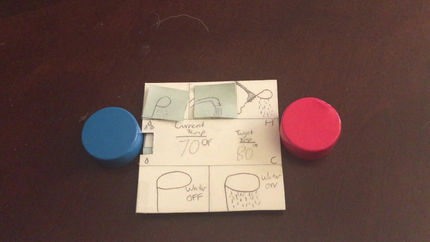WEEK 1
Paper Prototyping
Week one I used paper, tape, sticky notes, tooth picks, and bottle lids to make a shower control interface. The prototype includes a temperature control knob, a water flow volume knob, three valve control buttons (mounted shower head, handheld shower head, and tub spout), current and target temperature readings, and system control on and off buttons. Assignment constraints included the interface must fit within 4x4x2 inches, weight less than 0.75 pounds, must be visible and operable in steamy soapy situations, and must be operable by a user without their corrective lens or other aids that may not be suitable for use in a shower.
The design challenge was to create this shower control interface with the set specification in the brand and design style of OXO. To begin I dove into OXO’s website and familiarized myself with the brand so that when sketching and prototyping I had the simplicity and sleek elements of the brand in mind. Key factors of existing OXO shower products are reflected in my prototype through its compact size, mobility, and simplicity.
What specifically makes my prototype unique from other shower control interfaces is its intuitivity. Many current shower control systems leave users wondering where the water is going to come out when they turn it on or how to make the water warmer or colder. My shower control interface uses visual and tactile feedback through indicating which setting are set through the illumination of the button and screen and physical resistance in the knobs when a max or minimum setting is reached. Along with the physical resistance there are visual displays showing a target temperature based off of the temperature knob and a slide bar of water flow percentage based off the water flow knob.
After making the prototype I conducted informal users test of the prototype with my peers. The informal user testing showed that the prototype excelled at ensuring the user knew exactly what was set to happen when the shower turned on. A user could clearly read and check at any point what level their water flow is at, what temperature the shower is, and which valves water is set to run from. The informal user testing also showed that the hierarchy of the prototype needed to be improved. With the current design less frequently used features such as water valve are larger than more frequently used features such as water temperature displays and knob controls. From the informal user testing I have concluded that to improve the effectiveness of the design I would rearrange the features to better highlight more frequently used features before making another iteration of this prototype.




